1100NRS - Disaster Nursing Competencies: Annotated Bibliography
VerifiedAdded on 2023/04/24
|6
|1262
|79
Annotated Bibliography
AI Summary
This annotated bibliography presents a compilation and analysis of three research articles focusing on disaster nursing competencies. The first article investigates the preparedness of disaster nursing professionals, emphasizing the implementation of core competencies to improve patient care. It identifies educational knowledge gaps and research biases affecting the reliability of findings. The second article is a scoping review identifying eleven core competencies essential for disaster nursing, including critical thinking, communication, and ethical practices, while also noting limitations in addressing migration and mitigation strategies. The third article explores Hong Kong nurses' perceptions of required competencies, aligning with the ICN framework, and identifies risk assessment and management as crucial, while acknowledging limitations in assessing practical application. All articles contribute to understanding and improving disaster nursing education and practice.
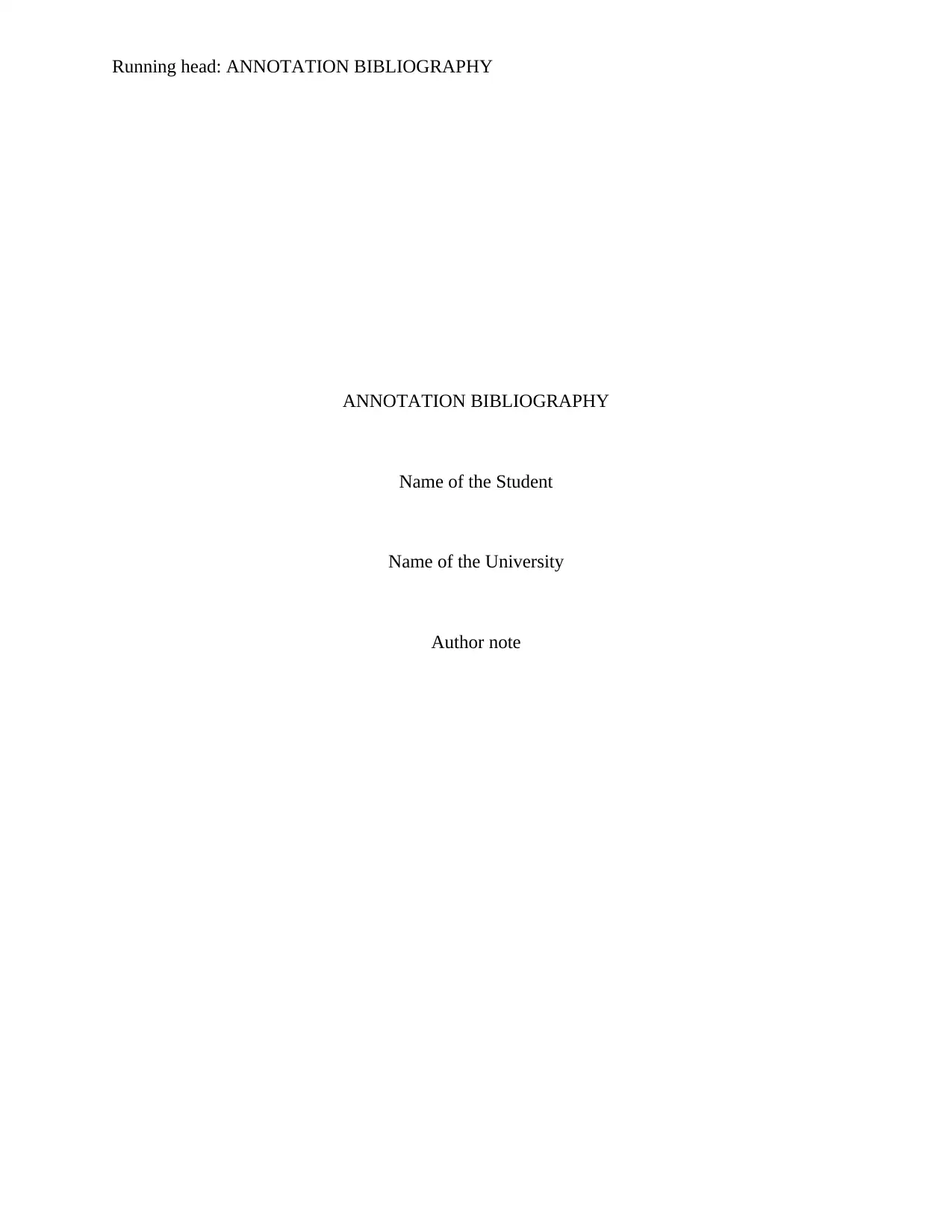
Running head: ANNOTATION BIBLIOGRAPHY
ANNOTATION BIBLIOGRAPHY
Name of the Student
Name of the University
Author note
ANNOTATION BIBLIOGRAPHY
Name of the Student
Name of the University
Author note
Paraphrase This Document
Need a fresh take? Get an instant paraphrase of this document with our AI Paraphraser
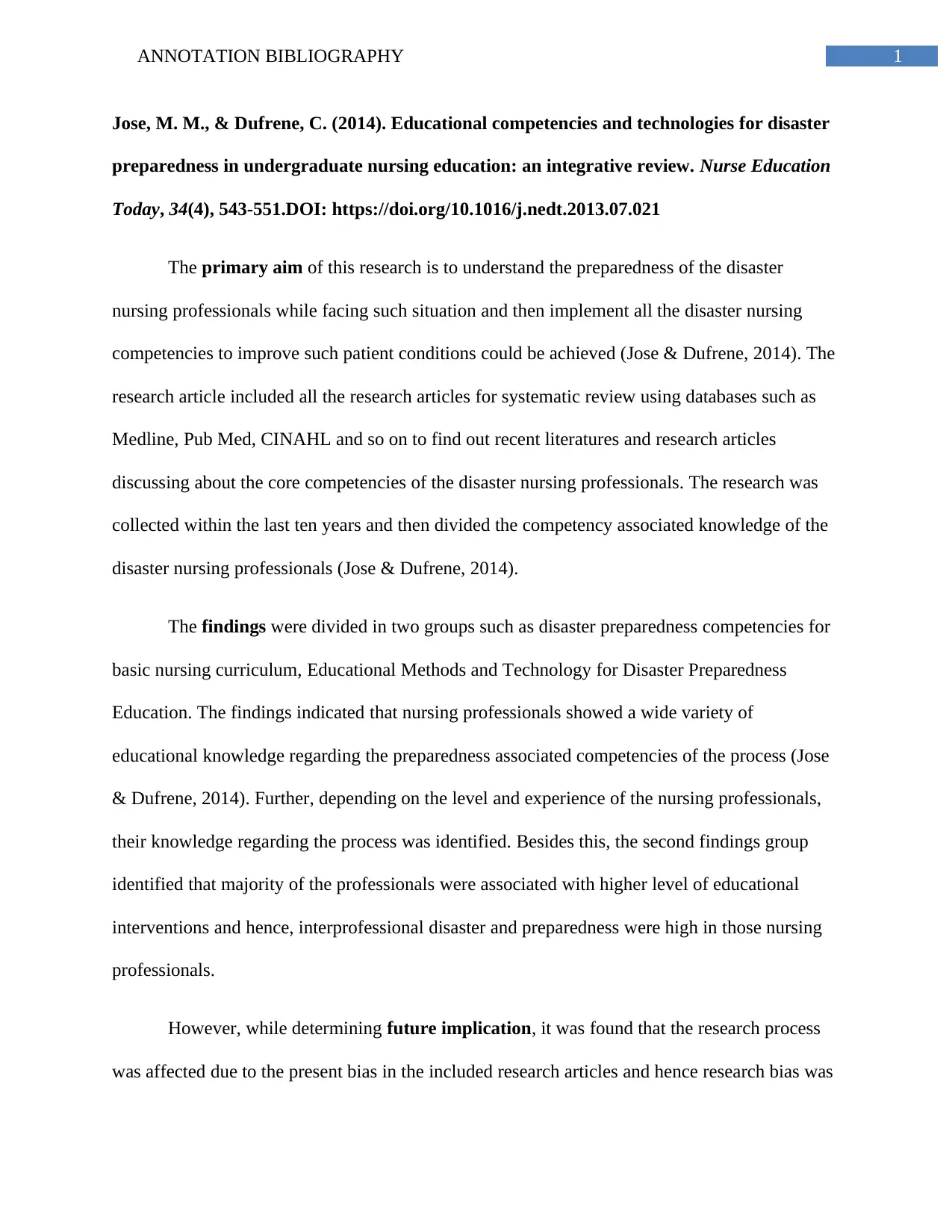
1ANNOTATION BIBLIOGRAPHY
Jose, M. M., & Dufrene, C. (2014). Educational competencies and technologies for disaster
preparedness in undergraduate nursing education: an integrative review. Nurse Education
Today, 34(4), 543-551.DOI: https://doi.org/10.1016/j.nedt.2013.07.021
The primary aim of this research is to understand the preparedness of the disaster
nursing professionals while facing such situation and then implement all the disaster nursing
competencies to improve such patient conditions could be achieved (Jose & Dufrene, 2014). The
research article included all the research articles for systematic review using databases such as
Medline, Pub Med, CINAHL and so on to find out recent literatures and research articles
discussing about the core competencies of the disaster nursing professionals. The research was
collected within the last ten years and then divided the competency associated knowledge of the
disaster nursing professionals (Jose & Dufrene, 2014).
The findings were divided in two groups such as disaster preparedness competencies for
basic nursing curriculum, Educational Methods and Technology for Disaster Preparedness
Education. The findings indicated that nursing professionals showed a wide variety of
educational knowledge regarding the preparedness associated competencies of the process (Jose
& Dufrene, 2014). Further, depending on the level and experience of the nursing professionals,
their knowledge regarding the process was identified. Besides this, the second findings group
identified that majority of the professionals were associated with higher level of educational
interventions and hence, interprofessional disaster and preparedness were high in those nursing
professionals.
However, while determining future implication, it was found that the research process
was affected due to the present bias in the included research articles and hence research bias was
Jose, M. M., & Dufrene, C. (2014). Educational competencies and technologies for disaster
preparedness in undergraduate nursing education: an integrative review. Nurse Education
Today, 34(4), 543-551.DOI: https://doi.org/10.1016/j.nedt.2013.07.021
The primary aim of this research is to understand the preparedness of the disaster
nursing professionals while facing such situation and then implement all the disaster nursing
competencies to improve such patient conditions could be achieved (Jose & Dufrene, 2014). The
research article included all the research articles for systematic review using databases such as
Medline, Pub Med, CINAHL and so on to find out recent literatures and research articles
discussing about the core competencies of the disaster nursing professionals. The research was
collected within the last ten years and then divided the competency associated knowledge of the
disaster nursing professionals (Jose & Dufrene, 2014).
The findings were divided in two groups such as disaster preparedness competencies for
basic nursing curriculum, Educational Methods and Technology for Disaster Preparedness
Education. The findings indicated that nursing professionals showed a wide variety of
educational knowledge regarding the preparedness associated competencies of the process (Jose
& Dufrene, 2014). Further, depending on the level and experience of the nursing professionals,
their knowledge regarding the process was identified. Besides this, the second findings group
identified that majority of the professionals were associated with higher level of educational
interventions and hence, interprofessional disaster and preparedness were high in those nursing
professionals.
However, while determining future implication, it was found that the research process
was affected due to the present bias in the included research articles and hence research bias was
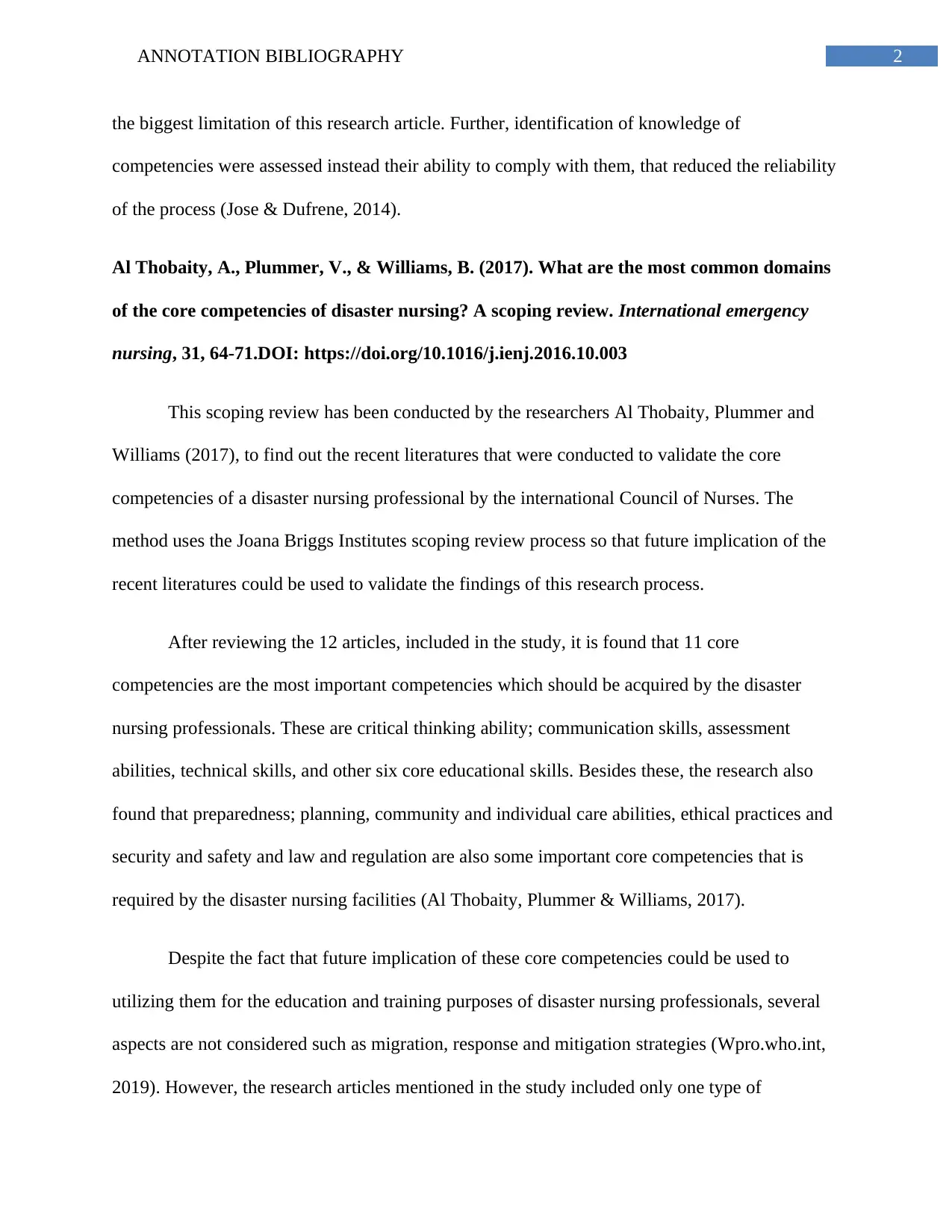
2ANNOTATION BIBLIOGRAPHY
the biggest limitation of this research article. Further, identification of knowledge of
competencies were assessed instead their ability to comply with them, that reduced the reliability
of the process (Jose & Dufrene, 2014).
Al Thobaity, A., Plummer, V., & Williams, B. (2017). What are the most common domains
of the core competencies of disaster nursing? A scoping review. International emergency
nursing, 31, 64-71.DOI: https://doi.org/10.1016/j.ienj.2016.10.003
This scoping review has been conducted by the researchers Al Thobaity, Plummer and
Williams (2017), to find out the recent literatures that were conducted to validate the core
competencies of a disaster nursing professional by the international Council of Nurses. The
method uses the Joana Briggs Institutes scoping review process so that future implication of the
recent literatures could be used to validate the findings of this research process.
After reviewing the 12 articles, included in the study, it is found that 11 core
competencies are the most important competencies which should be acquired by the disaster
nursing professionals. These are critical thinking ability; communication skills, assessment
abilities, technical skills, and other six core educational skills. Besides these, the research also
found that preparedness; planning, community and individual care abilities, ethical practices and
security and safety and law and regulation are also some important core competencies that is
required by the disaster nursing facilities (Al Thobaity, Plummer & Williams, 2017).
Despite the fact that future implication of these core competencies could be used to
utilizing them for the education and training purposes of disaster nursing professionals, several
aspects are not considered such as migration, response and mitigation strategies (Wpro.who.int,
2019). However, the research articles mentioned in the study included only one type of
the biggest limitation of this research article. Further, identification of knowledge of
competencies were assessed instead their ability to comply with them, that reduced the reliability
of the process (Jose & Dufrene, 2014).
Al Thobaity, A., Plummer, V., & Williams, B. (2017). What are the most common domains
of the core competencies of disaster nursing? A scoping review. International emergency
nursing, 31, 64-71.DOI: https://doi.org/10.1016/j.ienj.2016.10.003
This scoping review has been conducted by the researchers Al Thobaity, Plummer and
Williams (2017), to find out the recent literatures that were conducted to validate the core
competencies of a disaster nursing professional by the international Council of Nurses. The
method uses the Joana Briggs Institutes scoping review process so that future implication of the
recent literatures could be used to validate the findings of this research process.
After reviewing the 12 articles, included in the study, it is found that 11 core
competencies are the most important competencies which should be acquired by the disaster
nursing professionals. These are critical thinking ability; communication skills, assessment
abilities, technical skills, and other six core educational skills. Besides these, the research also
found that preparedness; planning, community and individual care abilities, ethical practices and
security and safety and law and regulation are also some important core competencies that is
required by the disaster nursing facilities (Al Thobaity, Plummer & Williams, 2017).
Despite the fact that future implication of these core competencies could be used to
utilizing them for the education and training purposes of disaster nursing professionals, several
aspects are not considered such as migration, response and mitigation strategies (Wpro.who.int,
2019). However, the research articles mentioned in the study included only one type of
⊘ This is a preview!⊘
Do you want full access?
Subscribe today to unlock all pages.

Trusted by 1+ million students worldwide
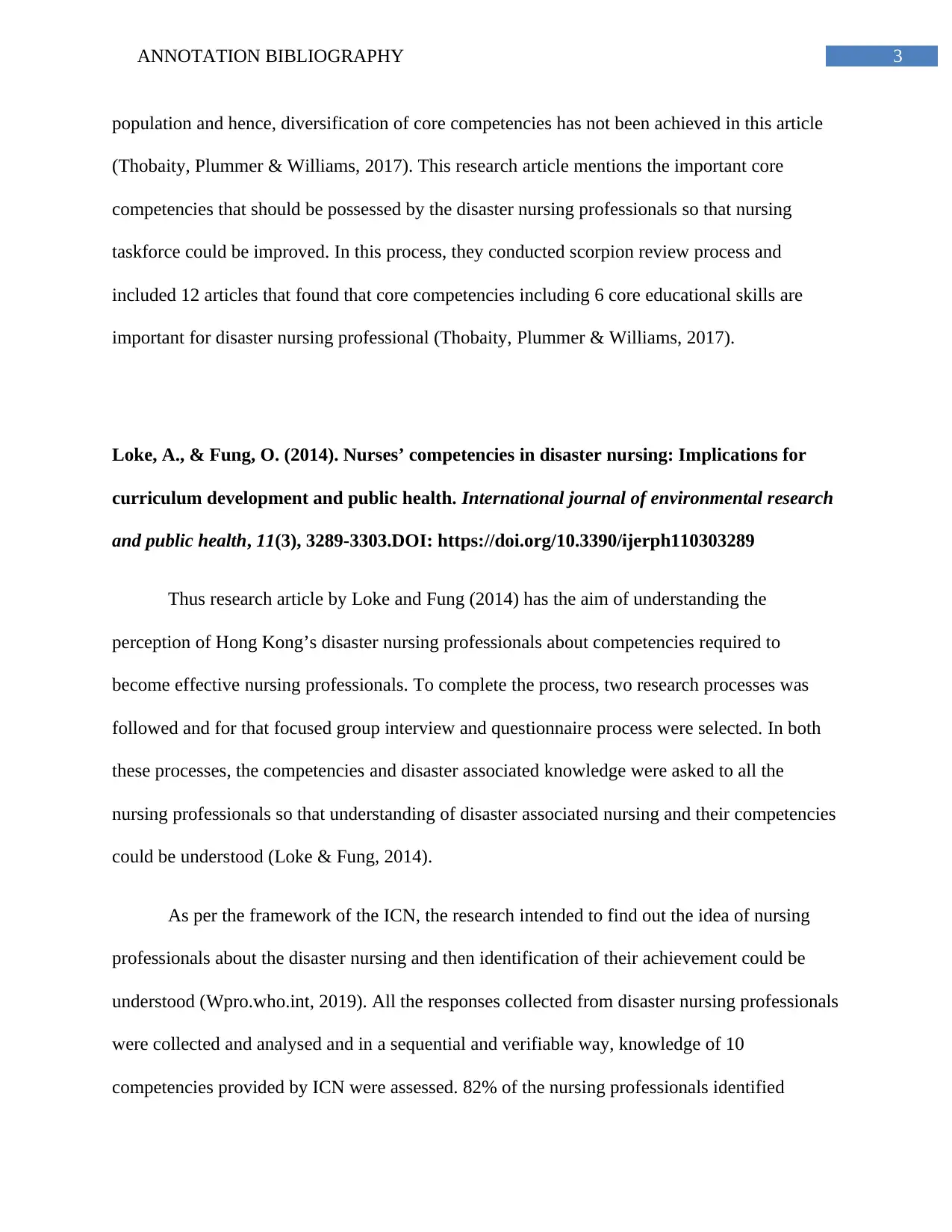
3ANNOTATION BIBLIOGRAPHY
population and hence, diversification of core competencies has not been achieved in this article
(Thobaity, Plummer & Williams, 2017). This research article mentions the important core
competencies that should be possessed by the disaster nursing professionals so that nursing
taskforce could be improved. In this process, they conducted scorpion review process and
included 12 articles that found that core competencies including 6 core educational skills are
important for disaster nursing professional (Thobaity, Plummer & Williams, 2017).
Loke, A., & Fung, O. (2014). Nurses’ competencies in disaster nursing: Implications for
curriculum development and public health. International journal of environmental research
and public health, 11(3), 3289-3303.DOI: https://doi.org/10.3390/ijerph110303289
Thus research article by Loke and Fung (2014) has the aim of understanding the
perception of Hong Kong’s disaster nursing professionals about competencies required to
become effective nursing professionals. To complete the process, two research processes was
followed and for that focused group interview and questionnaire process were selected. In both
these processes, the competencies and disaster associated knowledge were asked to all the
nursing professionals so that understanding of disaster associated nursing and their competencies
could be understood (Loke & Fung, 2014).
As per the framework of the ICN, the research intended to find out the idea of nursing
professionals about the disaster nursing and then identification of their achievement could be
understood (Wpro.who.int, 2019). All the responses collected from disaster nursing professionals
were collected and analysed and in a sequential and verifiable way, knowledge of 10
competencies provided by ICN were assessed. 82% of the nursing professionals identified
population and hence, diversification of core competencies has not been achieved in this article
(Thobaity, Plummer & Williams, 2017). This research article mentions the important core
competencies that should be possessed by the disaster nursing professionals so that nursing
taskforce could be improved. In this process, they conducted scorpion review process and
included 12 articles that found that core competencies including 6 core educational skills are
important for disaster nursing professional (Thobaity, Plummer & Williams, 2017).
Loke, A., & Fung, O. (2014). Nurses’ competencies in disaster nursing: Implications for
curriculum development and public health. International journal of environmental research
and public health, 11(3), 3289-3303.DOI: https://doi.org/10.3390/ijerph110303289
Thus research article by Loke and Fung (2014) has the aim of understanding the
perception of Hong Kong’s disaster nursing professionals about competencies required to
become effective nursing professionals. To complete the process, two research processes was
followed and for that focused group interview and questionnaire process were selected. In both
these processes, the competencies and disaster associated knowledge were asked to all the
nursing professionals so that understanding of disaster associated nursing and their competencies
could be understood (Loke & Fung, 2014).
As per the framework of the ICN, the research intended to find out the idea of nursing
professionals about the disaster nursing and then identification of their achievement could be
understood (Wpro.who.int, 2019). All the responses collected from disaster nursing professionals
were collected and analysed and in a sequential and verifiable way, knowledge of 10
competencies provided by ICN were assessed. 82% of the nursing professionals identified
Paraphrase This Document
Need a fresh take? Get an instant paraphrase of this document with our AI Paraphraser
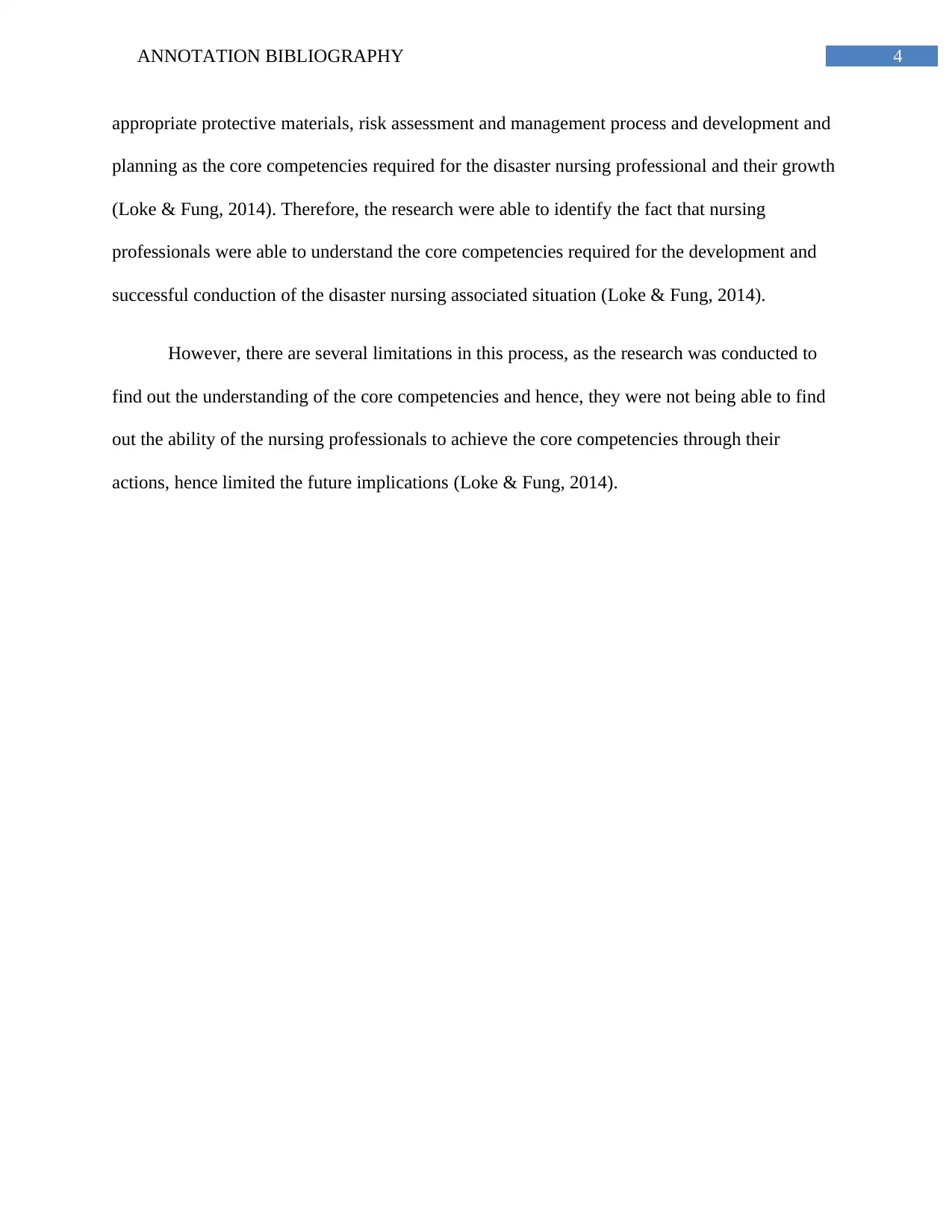
4ANNOTATION BIBLIOGRAPHY
appropriate protective materials, risk assessment and management process and development and
planning as the core competencies required for the disaster nursing professional and their growth
(Loke & Fung, 2014). Therefore, the research were able to identify the fact that nursing
professionals were able to understand the core competencies required for the development and
successful conduction of the disaster nursing associated situation (Loke & Fung, 2014).
However, there are several limitations in this process, as the research was conducted to
find out the understanding of the core competencies and hence, they were not being able to find
out the ability of the nursing professionals to achieve the core competencies through their
actions, hence limited the future implications (Loke & Fung, 2014).
appropriate protective materials, risk assessment and management process and development and
planning as the core competencies required for the disaster nursing professional and their growth
(Loke & Fung, 2014). Therefore, the research were able to identify the fact that nursing
professionals were able to understand the core competencies required for the development and
successful conduction of the disaster nursing associated situation (Loke & Fung, 2014).
However, there are several limitations in this process, as the research was conducted to
find out the understanding of the core competencies and hence, they were not being able to find
out the ability of the nursing professionals to achieve the core competencies through their
actions, hence limited the future implications (Loke & Fung, 2014).
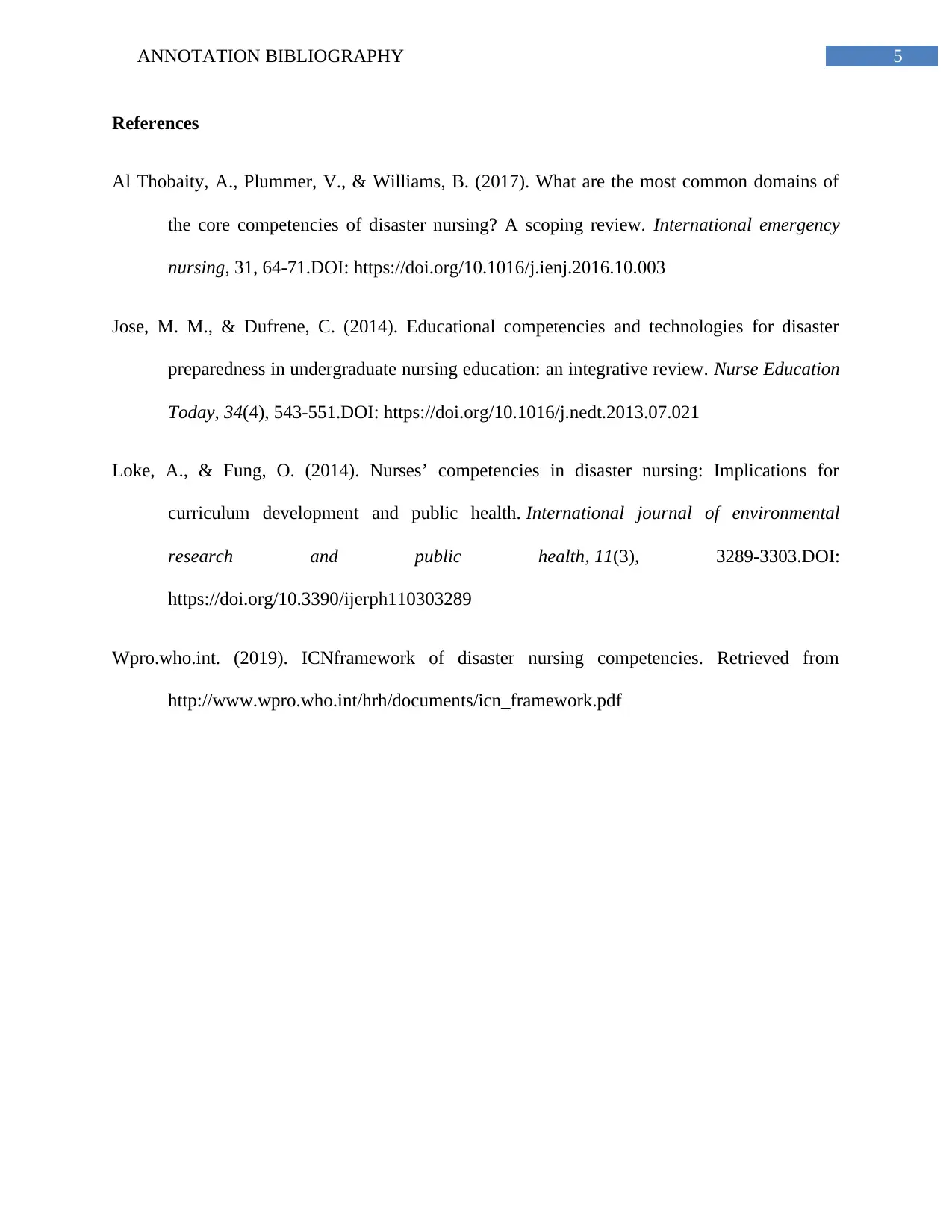
5ANNOTATION BIBLIOGRAPHY
References
Al Thobaity, A., Plummer, V., & Williams, B. (2017). What are the most common domains of
the core competencies of disaster nursing? A scoping review. International emergency
nursing, 31, 64-71.DOI: https://doi.org/10.1016/j.ienj.2016.10.003
Jose, M. M., & Dufrene, C. (2014). Educational competencies and technologies for disaster
preparedness in undergraduate nursing education: an integrative review. Nurse Education
Today, 34(4), 543-551.DOI: https://doi.org/10.1016/j.nedt.2013.07.021
Loke, A., & Fung, O. (2014). Nurses’ competencies in disaster nursing: Implications for
curriculum development and public health. International journal of environmental
research and public health, 11(3), 3289-3303.DOI:
https://doi.org/10.3390/ijerph110303289
Wpro.who.int. (2019). ICNframework of disaster nursing competencies. Retrieved from
http://www.wpro.who.int/hrh/documents/icn_framework.pdf
References
Al Thobaity, A., Plummer, V., & Williams, B. (2017). What are the most common domains of
the core competencies of disaster nursing? A scoping review. International emergency
nursing, 31, 64-71.DOI: https://doi.org/10.1016/j.ienj.2016.10.003
Jose, M. M., & Dufrene, C. (2014). Educational competencies and technologies for disaster
preparedness in undergraduate nursing education: an integrative review. Nurse Education
Today, 34(4), 543-551.DOI: https://doi.org/10.1016/j.nedt.2013.07.021
Loke, A., & Fung, O. (2014). Nurses’ competencies in disaster nursing: Implications for
curriculum development and public health. International journal of environmental
research and public health, 11(3), 3289-3303.DOI:
https://doi.org/10.3390/ijerph110303289
Wpro.who.int. (2019). ICNframework of disaster nursing competencies. Retrieved from
http://www.wpro.who.int/hrh/documents/icn_framework.pdf
⊘ This is a preview!⊘
Do you want full access?
Subscribe today to unlock all pages.

Trusted by 1+ million students worldwide
1 out of 6
Related Documents
Your All-in-One AI-Powered Toolkit for Academic Success.
+13062052269
info@desklib.com
Available 24*7 on WhatsApp / Email
![[object Object]](/_next/static/media/star-bottom.7253800d.svg)
Unlock your academic potential
Copyright © 2020–2025 A2Z Services. All Rights Reserved. Developed and managed by ZUCOL.





